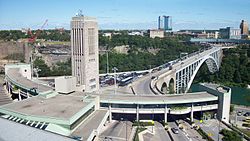Rainbow Bridge | |
|---|---|
 Rainbow Bridge, viewed from Niagara Falls Observation Tower | |
| Coordinates | 43°05′25″N79°04′04″W / 43.0902°N 79.0677°W |
| Carries | 4 lanes of NY 955A / |
| Crosses | Niagara River |
| Locale | Niagara Falls, Ontario, Canada and Niagara Falls, New York, U.S. |
| Official name | Niagara Falls International Rainbow Bridge |
| Maintained by | Niagara Falls Bridge Commission |
| Characteristics | |
| Design | Arch bridge of steel construction |
| Total length | 1,450 ft (440 m) [1] |
| Height | 202 ft (62 m) [1] |
| Longest span | 960 ft (290 m) [1] |
| History | |
| Construction cost | $4 million [1] |
| Opened | November 1, 1941 |
| Statistics | |
| Toll | $6.00 USD or $8.50 CAD per automobile $1.00 USD or CAD per bicyclist $1.25 CAD per pedestrian, US bound [2] |
| Location | |
 Interactive map of Rainbow Bridge | |
The Niagara Falls International Rainbow Bridge, commonly known as the Rainbow Bridge, is a steel arch bridge across the Niagara River, connecting the cities of Niagara Falls, New York, United States, and Niagara Falls, Ontario, Canada.







